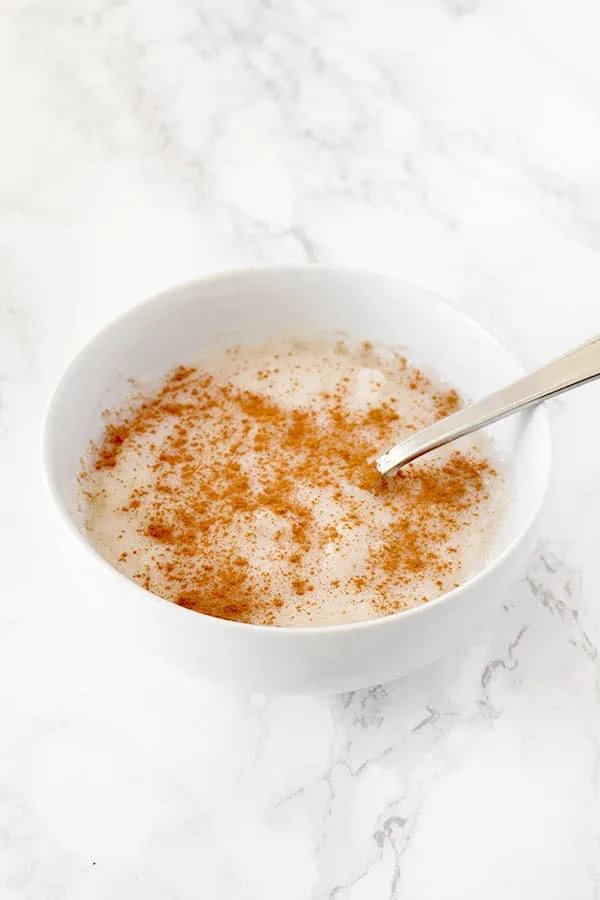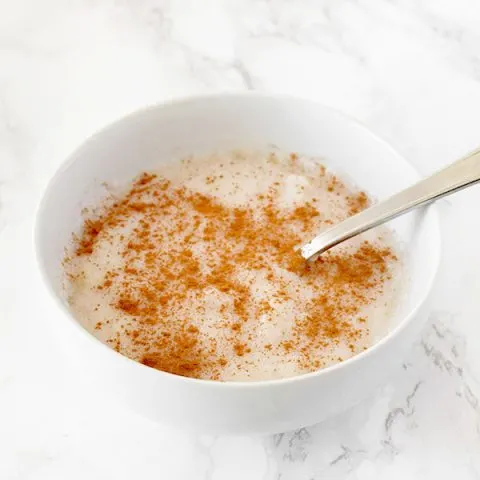Semolina porridge, also known as semolina porridge, is a popular breakfast in Israel. Here we call it diysa, though that technically means any hot cereal.
It is a wonderfully easy hot breakfast to enjoy on cold winter mornings.
It is also a nice change from oat meal, which is often my go-to hot breakfast on crisp days.
Growing up, my mom made a savory version of semolina porridge.
She cooks the semolina in a similar way to this recipe, but she leaves out the sugar and cinnamon and just adds salt.

I learned about the sweet version, which is actually more popular, when my brother went away to Hesder.
One weekend, he came home and told me about how there, they add cinnamon and sugar to theirs.
This reminded me of of how I like my oatmeal with cinnamon and brown sugar. Needless to say, I was in.
This version is probably what people usually think of when they say "semolina pudding".
It is actually very reminiscent of rice pudding.
Now, that is the only way I make it.
In fact, whenever we make diysa, we always have to make a sweet version and a savory version so everyone will be happy.
Other optional additions include fruit, berries, chocolate shavings, and really anything you want.
Semolina porridge has been eaten in Europe since Roman times, and the recipe book of Apicius recommends almonds, raisins, and raisin wine.
Is semolina porridge healthy?
The savory version is, but once you add sugar to make it sweet... not so much.
For a healthier alternative, you can try replacing the sugar with honey, real maple syrup, or molasses.
Is semolina or oats better?
That really is personal preference. For me, it mostly comes down to what I am in the mood for, because I think they are both delicious.
Which dairy free milk should I use?
Honestly, it's whatever you have on hand or prefer.
My go-to is a neutral flavored full fat oat milk because I find that they are the most similar to regular full fat milk.
Almond milk works well here, too. I personally like using an unsweetened barista almond milk because it is more similar to regular full fat milk, but whatever you have will work.
You can also use coconut milk, though it may have a subtle coconut flavor if you do. Coconut milk has more fat and is similar to using a light cream, but it won't make a noticeable difference.
I've never used soy milk, so I don't have any opinions on it, but you can use that as well.
Choosing your Brand
I have tried a handful of oat milk brands and I can tell you, not all oat milks are created equal.
Some brands taste like oats and have the consistency of water. Other brands have a milder taste and are slightly reminiscent of milk. Oatly and Alpro are my two go-to brands.
When I visit New York, I really like Oatly, which I find to taste like regular milk and to be a little extra creamy. I'd assume this is true in Canada too.
In Israel, I only use the barista version of Oatly, which is still more watery than the regular Oatly in the States. I expect it is the same in Europe because that is where it is imported from.
For Israel and Europe, I find the Alpro oat milk indistinguishable from the Oatly Barista. However, the Alpro "Not Milk" oat milk I find to be almost identical to milk but a little sweeter - which I like.
Sugar
The primary role of sugar is to be a sweetener. However, sugar also contributes to the tenderness and moistness of the baked good by absorbing and retaining moisture and helps create the golden brown color when baking as it caramelizes.
Recipes with more sugar often result in softer, moister textures. However, I learned the hard way that too much sugar leads to a sticky mess.
When it's heated, sugar caramelizes, resulting in a rich, complex flavor and a brown color. This adds both flavor and color to baked goods and is also the process in which caramel sauce, dulce de leche, caramel candies, and regular candies are made.
When used in recipes containing yeast, the sugar is eaten by the yeast, producing carbon dioxide and causing the dough to rise.
Sugar also acts as a preservative in jams, jellies, and fruit preserves by reducing water activity and preventing microbial growth.
There are many different types of sugar, including white sugar, brown sugar, vanilla sugar, powdered sugar, turbinado sugar, and demerara sugar.
When a recipe calls for “sugar” without specifying anything else, it's referring to regular white sugar.
White Sugar
White sugar (sometimes called granulated sugar, table sugar, or white granulated sugar) is made of either beet sugar or cane sugar, which has undergone a refining process.
It is the easiest to find and most commonly used.
Brown Sugar
Brown sugar is white sugar with molasses added to it.
It is commonly used in chocolate chip cookie recipes, and it’s rare for a recipe that calls for brown sugar not to also call for white sugar as well.
When a recipe calls for “brown sugar” but doesn’t specify what type (light or dark), it is referring to light brown sugar.
In my recipes, you can use whatever type of brown sugar you have on hand, whether it is dark brown sugar, light brown sugar, or demerara sugar - which is very common in Israel.
Just keep in mind that the flavor and color will be slightly different, depending on what you choose to use.
Turbinado Sugar
Turbinado sugar is better known as "raw sugar." But, despite this name, the sugar is not really “raw.”
Instead, it's partially refined sugar that retains some of the original molasses.
The term "raw sugar" may also give off the impression that it is somehow healthier.
In reality, turbinado sugar is nutritionally similar to white sugar.
Demerara Sugar
Demerara sugar is very popular in Israel and is especially delicious in tea, but is also used for baking.
Unlike white sugar, demerara sugar undergoes minimal processing and retains some vitamins and minerals.
However, it is still not much healthier than white sugar.
Vanilla Sugar
Vanilla sugar is not very common in the States. However, it is common in Israel and parts of Europe.
This is sugar that sat for an extended period of time with vanilla beans, giving it a vanilla flavor.
Caster Sugar
This type of sugar is common in the United Kingdom.
It has a grain finer than white (granulated) sugar and larger than powdered sugar.
Caster sugar is often called for in recipes for delicate baked goods like meringues, souffles, and sponge cakes.
You can use a 1:1 conversion rate between caster sugar and white (granulated) sugar.
Powdered sugar
Powdered sugar, sometimes known as confectioners’ sugar, is a sugar with a powdered texture.
This sugar is rarely used for baking. Instead, it is used for dusting desserts and making frosting, icing, and glazes.
In some countries, you can also find powdered vanilla sugar.
It is made the exact same way regular vanilla sugar is made. However, the sugar used is powdered instead of granulated.
Vanilla Extract vs Vanilla sugar
In my recipes, I don’t specify what kind of vanilla to use.
The reason for this is that in the States, vanilla extract is exclusively used.
Meanwhile in Israel, along with many European countries, vanilla sugar is common.
In most, if not all recipes, both vanilla extract and vanilla sugar can be used.
In recipes where vanilla sugar can be used instead of extract, you can replace them 1:1.
Replacing Sugar with Honey
If you’d prefer to use honey instead of sugar, you can do so with pretty good results.
Honey can be two or even three times as sweet depending on the honey, so for every 1 cup of sugar, you can use ½ to ⅔ cup honey.
Since honey adds liquid, you need to remove some to balance it out. For every cup of honey, remove a ¼ cup of liquid.
Also, it burns faster than granulated sugar, so you want to lower the baking temperature by 25 F. In addition, check it early and often to avoid burning or overbaking.
How to Store Sugar
Sugar should be stored in an airtight container to prevent clumping and moisture absorption, and kept in a cool, dry place.
Semolina Porridge

Semolina porridge is called diysa in Hebrew. It is a common hot breakfast like oatmeal is in the States.
Ingredients
- 2 cups milk or dairy free milk* (480 milliliters)
- 1 cup water (240 milliliters)
- ⅓ cup semolina (60 grams)
- 1 tablespoon sugar
- Pinch of salt
- Cinnamon for sprinkling, optional**
Instructions
- In a pot, add the milk and water and bring to a boil.
- Lower to a simmer and slowly add in the semolina while stirring to avoid clumps.
- Add the sugar and salt. Mix to combine.
- Cook until it thickens and becomes porridge-like.
- Top with cinnamon if desired.
Notes
*For a lighter version, I use only ¼ cup (60 milliliters) of milk and replace the rest with water.
**While cinnamon is a common topping, or at least how I've always had it, you can also add fruits, berries, or even chocolate shavings.
Nutrition Information:
Yield:
1Serving Size:
1Amount Per Serving: Calories: 628Total Fat: 15gSaturated Fat: 9gTrans Fat: 0gUnsaturated Fat: 5gCholesterol: 59mgSodium: 525mgCarbohydrates: 91gFiber: 4gSugar: 13gProtein: 33g
Beth
Wednesday 3rd of March 2021
Hi - is it semolina flour or meal or something else? I’d love the exact name of what you used. When on a kibbutz many many years ago we had dysa for breakfast but I didn’t know what it was. It reminded me of cream of wheat.
Tuesday 24th of May 2022
@Beth, Yes, me too!! ... Kibbutz Kinneret on the sea of Galilee 1987. I used to look forward to my breakfast so much!!!
ElissaBeth
Wednesday 3rd of March 2021
Semolina is just semolina. If you cannot find it, farina or couscous can work as decent substitutes.